openGauss 每日一练第 3 天打卡,巩固 openGauss 数据库和表基本操作基础知识!
学习目标
今天学习前三节课作业,活动详情请参考 每日一练:openGauss数据库在线实训课程。
前面每日一练链接:
openGauss每日一练第1天 | 数据库和表的基本操作(一)
openGauss每日一练第2天 | 数据库和表的基本操作(二)
课后作业 1
1.创建一个表 products
| 字段名 | 数据类型 | 含义 |
|---|---|---|
| product_id | INTEGER | 产品编号 |
| product_name | Char(30) | 产品名 |
| category | Char(20) | 种类 |
创建数据库和表
\l create database jiekexu; -- 查看数据库 \l -- 切换数据库 \c jiekexu --查看表 \d Create table products(product_id integer,product_name char(30),category char(20), primary key (product_id)); -- 查看表 \d jiekexu-# List of relations Schema | Name | Type | Owner | Storage --------+----------+-------+-------+---------------------------------- public | products | table | omm | {orientation=row,compression=no} (1 row) -- 查看索引信息 jiekexu-# \di List of relations Schema | Name | Type | Owner | Table | Storage --------+---------------+-------+-------+----------+--------- public | products_pkey | index | omm | products | (1 row) --显示表结构信息,与 Oracle、MySQL 中的 desc 效果差不多。 jiekexu-# \d products Table "public.products" Column | Type | Modifiers --------------+---------------+----------- product_id | integer | not null product_name | character(30) | category | character(20) | Indexes: "products_pkey" PRIMARY KEY, btree (product_id) TABLESPACE pg_default --\d+ 表名,显示比“\d”命令的执行结果更详细的信息,除了前面介绍的信息,还会显示所有与表的列关联的注释,以及表中出现的OID。 jiekexu-# \d+ products category | character(20) | | extended | | Indexes: "products_pkey" PRIMARY KEY, btree (product_id) TABLESPACE pg_default Has OIDs: no Options: orientation=row, compression=no jiekexu-# Table "public.products" Column | Type | Modifiers | Storage | Stats target | Description --------------+---------------+-----------+----------+--------------+------------- product_id | integer | not null | plain | | product_name | character(30) | | extended | | jiekexu-#复制
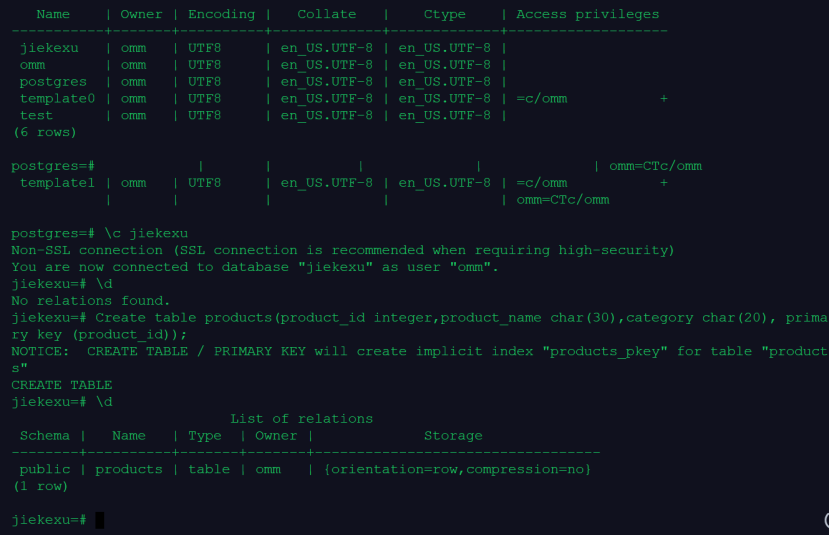
2.向表中插入数据,采用一次插入一条和多条记录的方式
| product_id | product_name | category |
|---|---|---|
| 1502 | olympus camera | electrncs |
| 1601 | lamaze | toys |
| 1700 | wait interface | Books |
| 1666 | harry potter | toys |
插入一行数据
--查看自动提交参数是否开启,如下为 on 自动提交开启。 jiekexu=# show autocommit; autocommit ------------ on (1 row) --自动提交,无需 commit. insert into products values('1502','olympus camera','electrncs');复制
插入多行数据
insert into products (product_id,product_name,category) values ('1601','lamaze','toys'), ('1700','wait interface','Books'), ('1666','harry potter','toys');复制
3.查询表中所有记录及记录数
jiekexu=# select * from products; product_id | product_name | category ------------+--------------------------------+---------------------- 1502 | olympus camera | electrncs 1601 | lamaze | toys 1700 | wait interface | Books 1666 | harry potter | toys (4 rows) jiekexu=# select count(*) from products; count ------- 4 (1 row)复制

4.查询表中所有category记录,并将查询结果按升序排序
jiekexu=# select category from products order by category; category ---------------------- Books electrncs toys toys (4 rows)复制
5.查询表中category为toys的记录
jiekexu=# select * from products where category='toys'; product_id | product_name | category ------------+--------------------------------+---------------------- 1601 | lamaze | toys 1666 | harry potter | toys (2 rows)复制
6.删除表 products
drop table products;复制
===================================================
课后作业 2
1.创建一个表 products
| 字段名 | 数据类型 | 含义 |
|---|---|---|
| product_id | INTEGER | 产品编号 |
| product_name | Char(30) | 产品名 |
| category | Char(20) | 种类 |
创建数据库和表
\l create database jiekexu; -- 查看数据库 \l -- 切换数据库 \c jiekexu --查看表 \d Create table products(product_id integer,product_name char(30),category char(20), primary key (product_id)); NOTICE: CREATE TABLE / PRIMARY KEY will create implicit index "products_pkey" for table "products" CREATE TABLE -- 查看表 \d jiekexu-# List of relations Schema | Name | Type | Owner | Storage --------+----------+-------+-------+---------------------------------- public | products | table | omm | {orientation=row,compression=no} (1 row)复制
2.向表中插入数据,采用一次插入一条和多条记录的方式
| product_id | product_name | category |
|---|---|---|
| 1502 | olympus camera | electrncs |
| 1601 | lamaze | toys |
| 1700 | wait interface | Books |
| 1666 | harry potter | toys |
插入一行数据
insert into products values('1502','olympus camera','electrncs');复制
插入多行数据
insert into products values ('1601','lamaze','toys'), ('1700','wait interface','Books'), ('1666','harry potter','toys'); --自动提交,无需 commit.复制
3.获取表中一条记录、三条记录和所有记录
jiekexu=# select * from products limit 1; product_id | product_name | category ------------+--------------------------------+---------------------- 1601 | lamaze | toys (1 row) jiekexu=# select * from products limit 3; product_id | product_name | category ------------+--------------------------------+---------------------- 1601 | lamaze | toys 1700 | wait interface | Books 1666 | harry potter | toys (3 rows) jiekexu=# select * from products; product_id | product_name | category ------------+--------------------------------+---------------------- 1601 | lamaze | toys 1700 | wait interface | Books 1666 | harry potter | toys 1502 | olympus camera | electrncs (4 rows)复制
4.将满足product_id > 1600的记录的product_id更新为product_id – 1000,并查看products中所有记录是否更新成功
select product_id from products; update products set product_id=product_id - 1000 where product_id > 1600; select product_id from products;复制
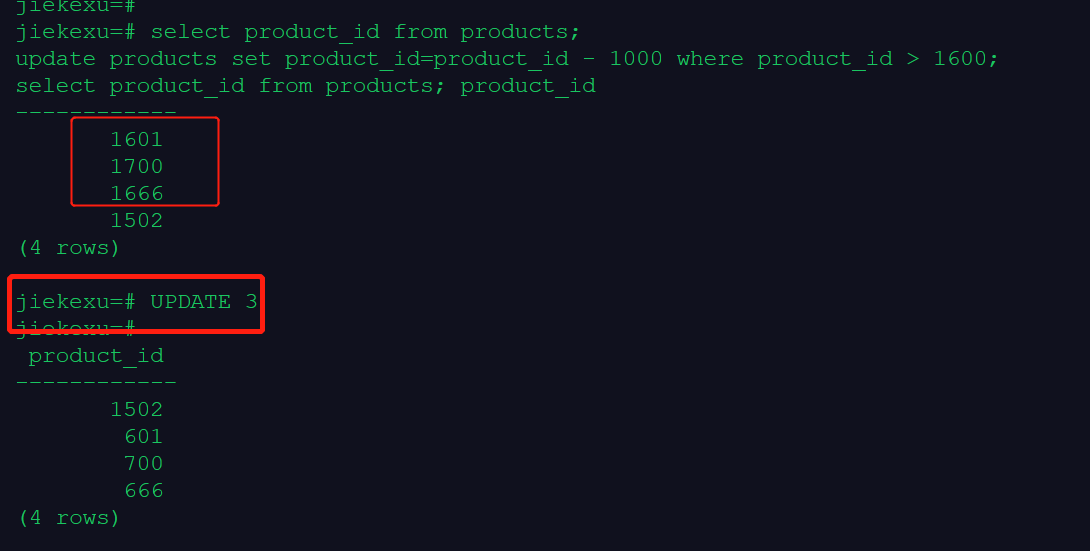
5.删除category为toys的所有记录,并查看products中数据是否删除成功
jiekexu=# show autocommit; autocommit ------------ on (1 row) select category from products; delete from products where category='toys'; select category from products;复制
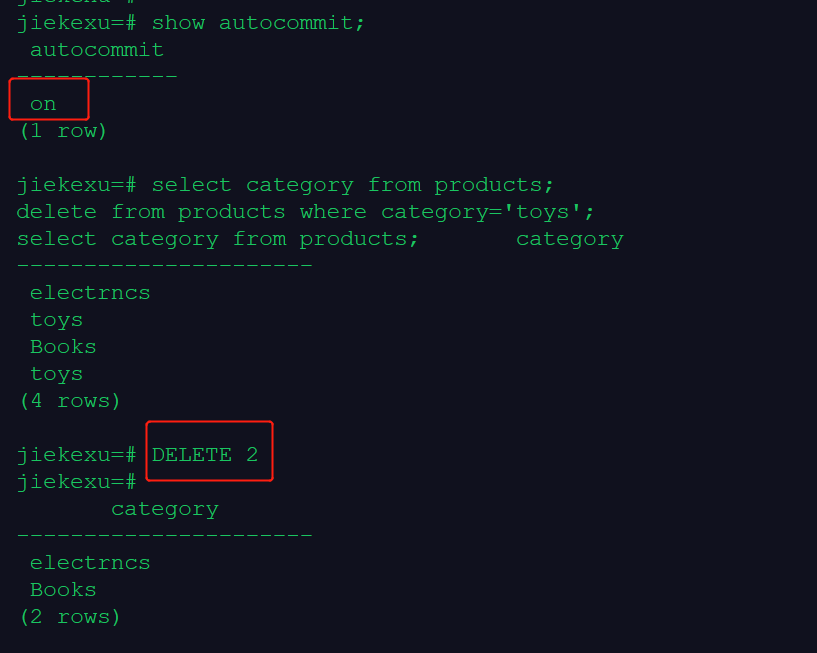
6.删除products中所有数据,并查看数据是否删除成功
\d delete from products; select * from products; \d Schema | Name | Type | Owner | Storage --------+----------+-------+-------+---------------------------------- public | products | table | omm | {orientation=row,compression=no} (1 row) jiekexu=# DELETE 2 jiekexu=# product_id | product_name | category ------------+--------------+---------- (0 rows) jiekexu=# List of relations Schema | Name | Type | Owner | Storage --------+----------+-------+-------+---------------------------------- public | products | table | omm | {orientation=row,compression=no} (1 row)复制
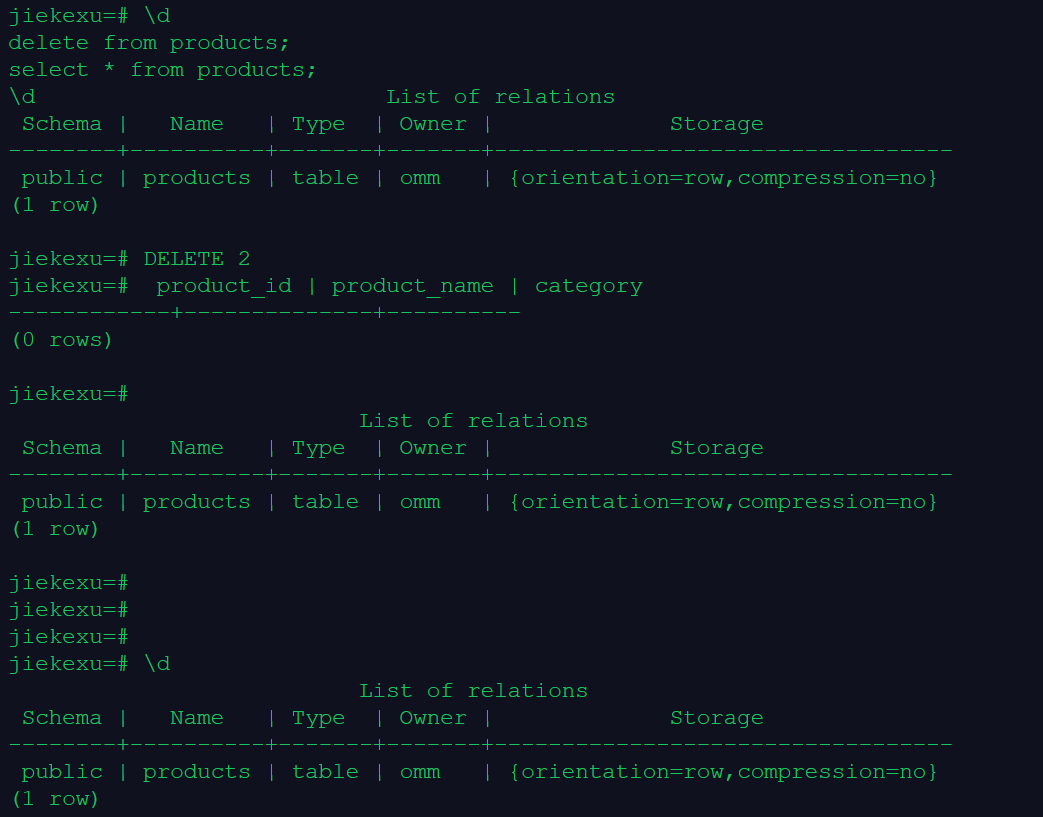
7.删除表 products
drop table products; jiekexu=# \d List of relations Schema | Name | Type | Owner | Storage --------+----------+-------+-------+---------------------------------- public | products | table | omm | {orientation=row,compression=no} (1 row) jiekexu=# select * from products; product_id | product_name | category ------------+--------------+---------- (0 rows) jiekexu=# jiekexu=# drop table products; DROP TABLE jiekexu=# \d No relations found.复制
=======================================
课后作业 3
1.分别创建名为 tpcc1 和 tpcc2 的数据库
\l create database tpcc1; create database tpcc2; \l jiekexu=# \l List of databases Name | Owner | Encoding | Collate | Ctype | Access privileges -----------+-------+----------+-------------+-------------+------------------- jiekexu | omm | UTF8 | en_US.UTF-8 | en_US.UTF-8 | omm | omm | UTF8 | en_US.UTF-8 | en_US.UTF-8 | postgres | omm | UTF8 | en_US.UTF-8 | en_US.UTF-8 | template0 | omm | UTF8 | en_US.UTF-8 | en_US.UTF-8 | =c/omm + | | | | | omm=CTc/omm template1 | omm | UTF8 | en_US.UTF-8 | en_US.UTF-8 | =c/omm + | | | | | omm=CTc/omm test | omm | UTF8 | en_US.UTF-8 | en_US.UTF-8 | tpcc1 | omm | UTF8 | en_US.UTF-8 | en_US.UTF-8 | tpcc2 | omm | UTF8 | en_US.UTF-8 | en_US.UTF-8 | (8 rows)复制
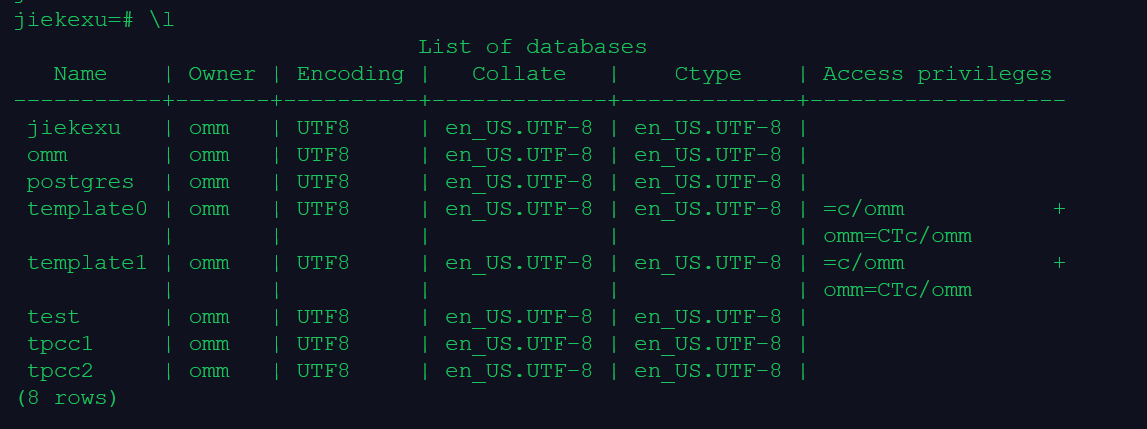
jiekexu=# CREATE DATABASE music; CREATE DATABASE jiekexu=# jiekexu=# \l List of databases Name | Owner | Encoding | Collate | Ctype | Access privileges -----------+-------+----------+-------------+-------------+------------------- jiekexu | omm | UTF8 | en_US.UTF-8 | en_US.UTF-8 | music | omm | UTF8 | en_US.UTF-8 | en_US.UTF-8 | omm | omm | UTF8 | en_US.UTF-8 | en_US.UTF-8 | postgres | omm | UTF8 | en_US.UTF-8 | en_US.UTF-8 | template0 | omm | UTF8 | en_US.UTF-8 | en_US.UTF-8 | =c/omm + | | | | | omm=CTc/omm template1 | omm | UTF8 | en_US.UTF-8 | en_US.UTF-8 | =c/omm + | | | | | omm=CTc/omm test | omm | UTF8 | en_US.UTF-8 | en_US.UTF-8 | (7 rows) jiekexu=# SELECT DATNAME,DATCONNLIMIT FROM PG_DATABASE WHERE DATNAME='music'; datname | datconnlimit ---------+-------------- music | -1 (1 row) jiekexu=# ALTER DATABASE music CONNECTION LIMIT= 10; ALTER DATABASE jiekexu=# SELECT DATNAME,DATCONNLIMIT FROM PG_DATABASE WHERE DATNAME='music'; jiekexu=# datname | datconnlimit ---------+-------------- music | 10 (1 row)复制
2.将 tpcc1 数据库重命名为 tpcc10
alter database ptcc1 rename to ptcc10; jiekexu=# alter database tpcc1 rename to tpcc10; ALTER DATABASE jiekexu=# \l List of databases Name | Owner | Encoding | Collate | Ctype | Access privileges -----------+-------+----------+-------------+-------------+------------------- jiekexu | omm | UTF8 | en_US.UTF-8 | en_US.UTF-8 | omm | omm | UTF8 | en_US.UTF-8 | en_US.UTF-8 | postgres | omm | UTF8 | en_US.UTF-8 | en_US.UTF-8 | template0 | omm | UTF8 | en_US.UTF-8 | en_US.UTF-8 | =c/omm + | | | | | omm=CTc/omm template1 | omm | UTF8 | en_US.UTF-8 | en_US.UTF-8 | =c/omm + | | | | | omm=CTc/omm test | omm | UTF8 | en_US.UTF-8 | en_US.UTF-8 | tpcc10 | omm | UTF8 | en_US.UTF-8 | en_US.UTF-8 | tpcc2 | omm | UTF8 | en_US.UTF-8 | en_US.UTF-8 | (8 rows)复制
3.分别使用\l和\l+两个元命令查看数据库信息
jiekexu=# \l List of databases Name | Owner | Encoding | Collate | Ctype | Access privileges -----------+-------+----------+-------------+-------------+------------------- jiekexu | omm | UTF8 | en_US.UTF-8 | en_US.UTF-8 | omm | omm | UTF8 | en_US.UTF-8 | en_US.UTF-8 | postgres | omm | UTF8 | en_US.UTF-8 | en_US.UTF-8 | template0 | omm | UTF8 | en_US.UTF-8 | en_US.UTF-8 | =c/omm + | | | | | omm=CTc/omm template1 | omm | UTF8 | en_US.UTF-8 | en_US.UTF-8 | =c/omm + | | | | | omm=CTc/omm test | omm | UTF8 | en_US.UTF-8 | en_US.UTF-8 | tpcc10 | omm | UTF8 | en_US.UTF-8 | en_US.UTF-8 | tpcc2 | omm | UTF8 | en_US.UTF-8 | en_US.UTF-8 | (8 rows) jiekexu=# \l+ List of databases Name | Owner | Encoding | Collate | Ctype | Access privileges | Size | Tablespac e | Description -----------+-------+----------+-------------+-------------+-------------------+-------+---------- --+-------------------------------------------- jiekexu | omm | UTF8 | en_US.UTF-8 | en_US.UTF-8 | | 10 MB | pg_defaul t | omm | omm | UTF8 | en_US.UTF-8 | en_US.UTF-8 | | 10 MB | pg_defaul t | postgres | omm | UTF8 | en_US.UTF-8 | en_US.UTF-8 | | 10 MB | pg_defaul t | default administrative connection database template0 | omm | UTF8 | en_US.UTF-8 | en_US.UTF-8 | =c/omm +| 10 MB | pg_defaul t | default template for new databases t | unmodifiable empty database | | | | | omm=CTc/omm | | | test | omm | UTF8 | en_US.UTF-8 | en_US.UTF-8 | | 10 MB | pg_defaul t | | | | | | omm=CTc/omm | | | template1 | omm | UTF8 | en_US.UTF-8 | en_US.UTF-8 | =c/omm +| 10 MB | pg_defaul tpcc10 | omm | UTF8 | en_US.UTF-8 | en_US.UTF-8 | | 10 MB | pg_defaul t | tpcc2 | omm | UTF8 | en_US.UTF-8 | en_US.UTF-8 | | 10 MB | pg_defaul t | (8 rows)复制
4.在数据库 tpcc2 中创建 customer 表,字段自定义
\c tpcc2 \d create table customer(id int); \d jiekexu=# \c tpcc2 \d create table customer(id int); \dNon-SSL connection (SSL connection is recommended when requiring high-security) You are now connected to database "tpcc2" as user "omm". tpcc2=# No relations found. tpcc2=# CREATE TABLE tpcc2=# List of relations Schema | Name | Type | Owner | Storage --------+----------+-------+-------+---------------------------------- public | customer | table | omm | {orientation=row,compression=no} (1 row)复制
5.删除新创建的数据库
\l drop database tpcc2; drop database tpcc10; \l 注意:tpcc2=# ERROR: cannot drop the currently open database 不能够删除当前连接的数据库,需要切换到其他库才可删除此库。复制
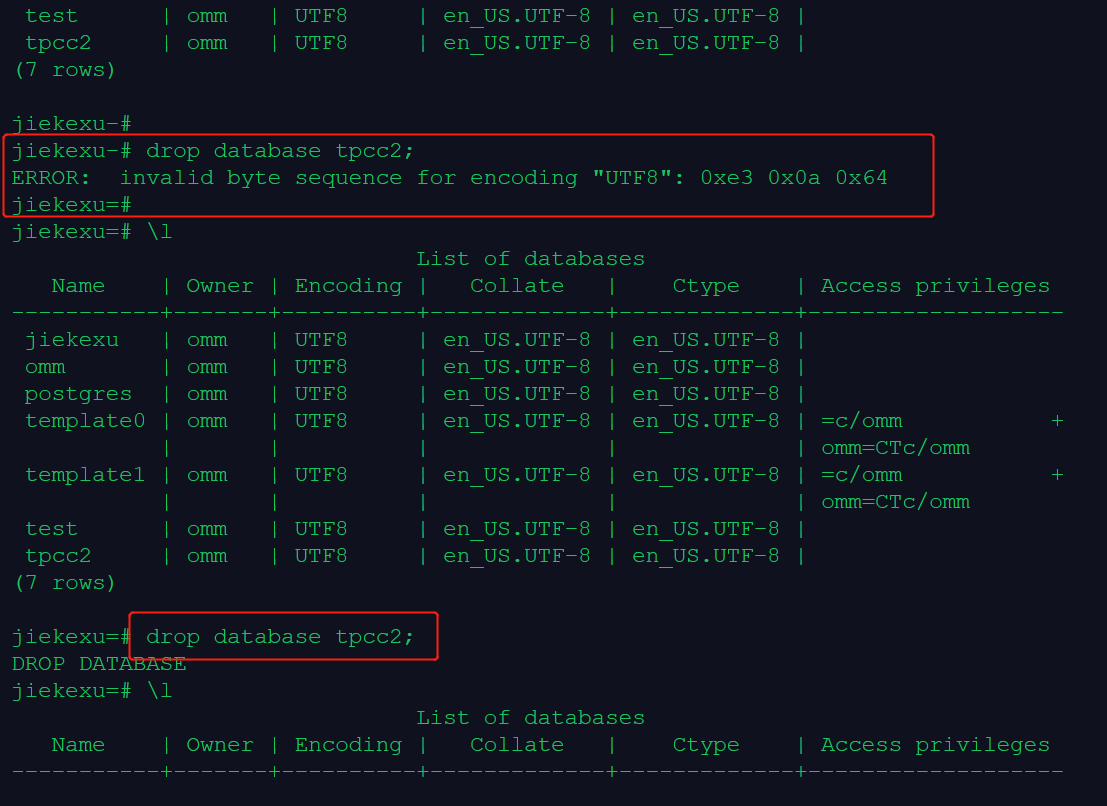
6.退出gsql程序
\q 或者 Ctrl + d 退出。复制
欧耶,前三课作业实操练习完成啦!
最后修改时间:2021-12-06 12:58:19
「喜欢这篇文章,您的关注和赞赏是给作者最好的鼓励」
关注作者
【版权声明】本文为墨天轮用户原创内容,转载时必须标注文章的来源(墨天轮),文章链接,文章作者等基本信息,否则作者和墨天轮有权追究责任。如果您发现墨天轮中有涉嫌抄袭或者侵权的内容,欢迎发送邮件至:contact@modb.pro进行举报,并提供相关证据,一经查实,墨天轮将立刻删除相关内容。
评论
您好,您的文章已入选合格奖,10墨值奖励已经到账请查收!
❤️我们还会实时派发您的流量收益。
3年前
 点赞
点赞 评论
相关阅读
openGauss荣获中国软件行业协会多奖项,技术升级再创行业新高度
openGauss
457次阅读
2025-04-30 14:30:58
MogDB 发布更新,解决 openGauss 数据库在长事务情况下Ustore表膨胀问题
MogDB
300次阅读
2025-04-17 10:41:41
MogDB 发布更新,解决 openGauss 数据库在长事务情况下Ustore表膨胀问题
云和恩墨
198次阅读
2025-04-16 09:52:02
GitCode 成 openGauss 新归宿,国产开源数据库里程碑事件
严少安
155次阅读
2025-04-27 11:37:53
荣誉时刻!openGauss认证证书快递已发,快来看看谁榜上有名!
墨天轮小教习
150次阅读
2025-04-23 17:39:13
单个执行机并行执行MySQL到openGauss数据迁移子任务
Clipnosis
129次阅读
2025-04-30 16:39:58
openGauss6.0.0适配操作系统自带的软件,不依赖三方库
来杯拿铁
90次阅读
2025-04-18 10:49:53
opengauss使用gs_probackup进行增量备份恢复
进击的CJR
85次阅读
2025-04-09 16:11:58
Postgresql数据库单个Page最多存储多少行数据
maozicb
79次阅读
2025-04-23 16:02:19
openGauss新特性 | openGauss-DataVec向量数据库特性介绍
openGauss
49次阅读
2025-04-17 10:41:47











